Training the muscles of the chest is a crucial component of any effective exercise program. While some people may want to specifically target their inner chest, the reality is that it’s unlikely we can isolate specific parts of this muscle group, as most exercises that work the chest will engage more than just one portion of the muscle. Whether or not different chest exercises provide differential growth in specific muscle areas, e.g., regional hypertrophy, is up for debate.
Fortunately, whether differences in regional hypertrophy from different exercises are possible or not doesn’t really change our recommendations when it comes to increasing muscle size. Rather, we stick to the same general approach for maximizing muscle growth, e.g., use a variety of exercises that challenge the muscle from different angles, use relatively long ranges of motion, are adaptable to different rep ranges, and can be progressively loaded.
In this article, we’ll outline 5 of our favorite exercises: Incline Bench Press, Flat Dumbbell Bench Press, Dumbbell Flyes, High-to-low Cable Flyes, and the Dumbbell Hex Press.
Let’s dive in!
More Chest Content on Barbell Medicine:
- Best Chest Exercises for Hypertrophy
- Best Chest Workout With Dumbbell
- Best Chest Workout without Equipment
- Best Cable Chest Exercises
- Best Inner Chest Exercises
- Best Upper Chest Exercises
- Best Lower Chest Exercises
- Best Chest and Biceps Workout
- Best Chest and Shoulder Workout
What are the Best Inner Chest Workout Exercises?
- Incline Bench Press: 3-4 sets of 5-8 repetitions
- Flat Dumbbell Bench Press: 3 sets of 10 repetitions
- Dumbbell Flyes: 2 to 4 sets of 10 to 15 repetitions
- High-to-low Cable Flyes: 2-4 sets of 10-15 repetitions
- Dumbbell Hex Press: 2-4 sets of 10-15 repetitions
As we established, when it comes to performing inner chest exercises, it’s difficult to really isolate the inner chest area in the same way as you would when training other muscle groups, such as your triceps. This is because the inner chest isn’t a separate muscle — it’s part of your pecs as a whole. Put simply, training your inner chest area means training your whole chest to some degree.
To secure maximum gains, it’s important to follow the general principles of hypertrophy training: train the muscle through a relatively large range of motion, use exercises that load the muscle at a variety of different angles, and use weights that get you somewhere near failure.
The number of exercises per workout and per week, as well as the total volume (how many reps and sets) needed to increase muscle size, will vary based on the individual and their body, fitness level, and training split, but we’ll share some general recommendations.
1. Incline Bench Press
Whether you opt for the classic bench press or some of its variations, such as the incline bench press, the exercise remains one of the best out there for muscle hypertrophy, as it strengthens the musculature of your whole upper body. More specifically, the incline bench press targets your chest and triceps alongside synergists such as the anterior deltoid.
In terms of the most suitable angle for the bench press, it all comes down to individual preferences. If you’re looking to obtain more strength, opt for a lower incline (for example, 15 degrees relative to horizontal). On the other hand, sticking to a higher incline (such as 45 or 70 degrees) is likely to transfer better to an overhand press. Equipment-wise, you need a barbell and an incline bench to perform the exercise.
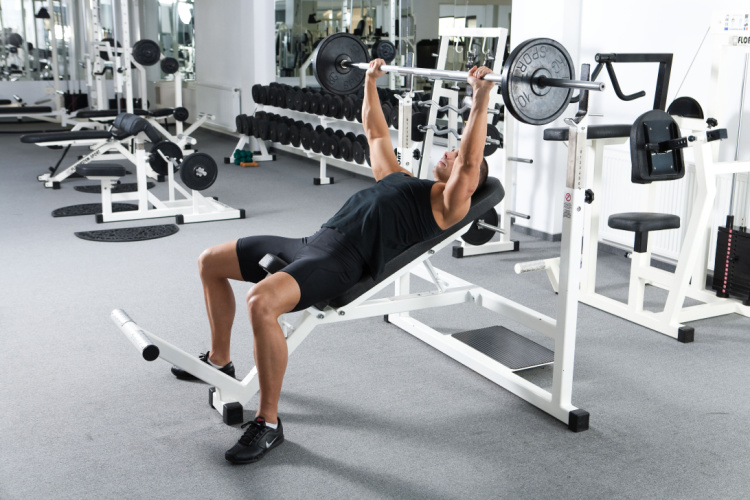
Movement Category: Primary
Programming: 3-4 sets of 5-8 repetitions
Weight: Use a weight that leaves you 2 to 3 reps short of failure, e.g. RPE 7 to 8.
How to do the incline bench press:
- Adjust the bench to anywhere from 15 to 30 degrees.
- Place your shoulder blades flat on the bench. Make sure both of your feet are firmly on the floor.
- Breathe deeply, then lift upon exhaling.
- Do the movement with a spotter if needed.
- Take a few moments to get used to the weight. Check whether the muscles in your upper back remain firm.
- Take a breath and gently bring the barbell back down. The barbell should be near the base of your breastbone when it’s at its lowest position.
2. Flat Dumbbell Bench Press
The dumbbell bench press is a variation on the barbell bench press that works your pecs as well as synergist muscles such as the deltoids and triceps. It also puts more strain on the stabilizing muscles that allow your arms to move both independently and in unison. If your goal is to gain more strength or muscular growth, you can use it as an addition to your current routine or as a stand-alone.
The dumbbell bench press is perfect for lifters of all levels who want to increase their stability as well as novices who want to work on developing their strength. You’ll need a bench and a pair of dumbbells to perform this exercise.
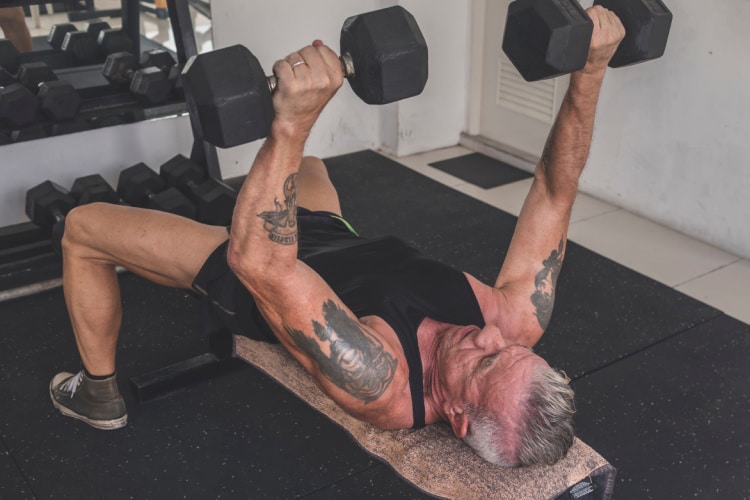
Movement Category: Secondary
Programming: 3 sets of 10 repetitions.
Weight: Use a weight that leaves you 2 to 3 reps short of failure, e.g., RPE 7 to 8.
How to do the flat dumbbell bench press:
- Take the dumbbells with both hands facing in using a neutral grip.
- Place the ends of the dumbbells into your hip crease while seated on the bench. Lie back and hold the weights close to your chest to position yourself.
- When you’re prepared, inhale and proceed with pressing the dumbbells to lockout at the top. When the dumbbell handles are about at the same height as your chest, lower the weights carefully.
- Contract your chest and push the dumbbells back up to the starting position.
Ensure both feet are flat and pressing the floor at all times. This prevents your body from moving.
3. Dumbbell Flyes
An upper-body isolation (single-joint) exercise, the dumbbell fly works your chest, shoulders, and triceps. Data measuring muscle excitation (EMG) shows that dumbbell flyes rely heavily on the pectoralis major, biceps brachii, and anterior deltoid. Compared to the bench press, a dumbbell flye uses relatively little triceps brachii to perform. [1]
Unlike a multi-joint exercise like a barbell or a dumbbell bench press, the dumbbell flye focuses on movement of the shoulder and involves minimal elbow movement.
Additionally, multi-joint workouts typically involve more muscle groups and larger weights than isolation exercises for a single joint. Isolation exercises, however, make it easier for a person to focus on particular muscles and reduce training-related tiredness, which makes them an excellent option for building muscle mass. [2]
Last but not least, another big benefit is that this exercise works as a chest opener, which helps reduce back pain, boost range of motion, and lessen stiffness in the upper body area.
The equipment you need for it are two dumbbells and a flat bench.
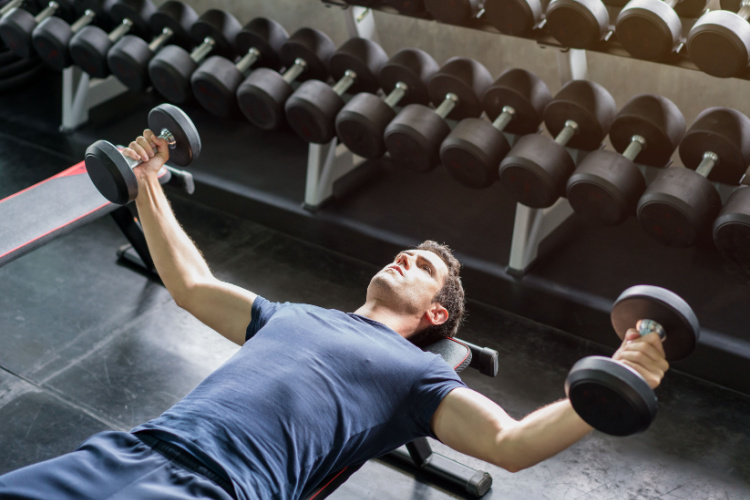
Movement Category: Tertiary
Programming: 2 to 4 sets of 10 to 15 repetitions.
Weight: Use a weight that leaves you 1 to 2 reps short of failure, e.g., RPE 8 to 9.
How to do the dumbbell flyes:
- Lie down on your back on the incline bench. Set both of your feet firmly on the floor. Keep your head and back firmly onto the bench during the entire exercise.
- You can either grab the dumbbells or have a spotter help you.
- Raise your arms above your head. They should be stretched but not locked out.
- Ensure that your elbows are slightly bent and that your hands and the dumbbells are facing each other.
- Breathe deeply, then slowly lower the dumbbells in an arc motion to your sides until they are in line with your chest. Again, don’t lock them out; instead, extend your arms to both sides. The idea is to have your arms roughly parallel to your shoulders and chest.
- To reverse the movement, consider pulling the dumbbells “up” and “back together.” At the top, the dumbbells should be exactly above your shoulder joint.
4. High-to-Low Cable Flyes
An isolation exercise using a cable stack to improve the lower portion of your pectoral muscles, the high-to-low cable fly also strengthens your body’s pushing muscles such as the triceps and shoulders. It’s a very straightforward exercise, so it’s suitable for both beginners and pros.
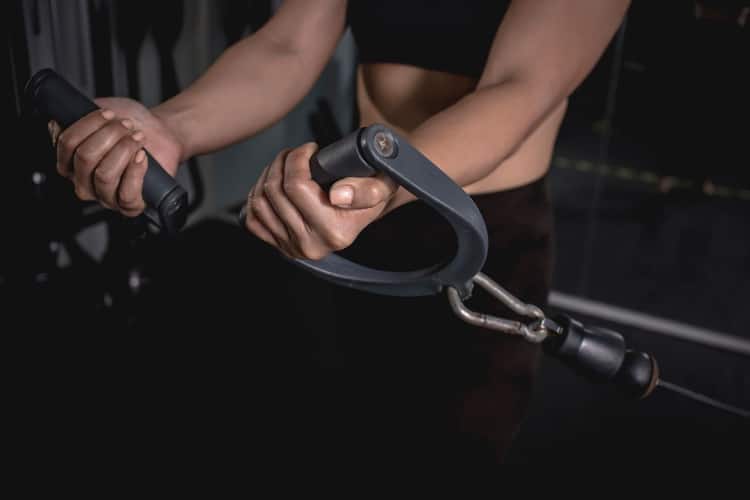
Movement Category:Tertiary
Programming: 2-4 sets of 10-15 repetitions
Weight: Use a weight that leaves you 1 to 2 reps short of failure, e.g. RPE 8 to 9.
How to do a high-to-low cable fly:
- Place the handles on the high pulleys of a cable crossover machine — you’ll want them at head height or slightly higher.
- Take the handles in both hands and pull them down towards the front of your hips. Place one leg in front of the other in a split stance so it’s easier to keep your balance.
- Make sure your abs are activated, your shoulders are back and down, and your elbows are slightly flexed but stiff.
- Open your hands and raise them out and back to approximately shoulder level to open up the chest, but be careful not to overstretch the shoulders. Repeat the movement.
5. Dumbbell Hex Press
Like the majority of chest exercises, the dumbbell hex press targets the pecs but also works other muscles, such as the anterior deltoid, the lateral deltoids, and the triceps. It’s an isometric training exercise that truly boosts your pressing game, as you’re not just pressing with your chest but also squeezing the muscles together in the process.
Ideally, this exercise should be performed with hexagonal dumbbells that touch each other during the movement. That said, if you don’t have access to hexagonally-shaped dumbbells, you can always use a regular pair of dumbbells as long as you can push them into each other.
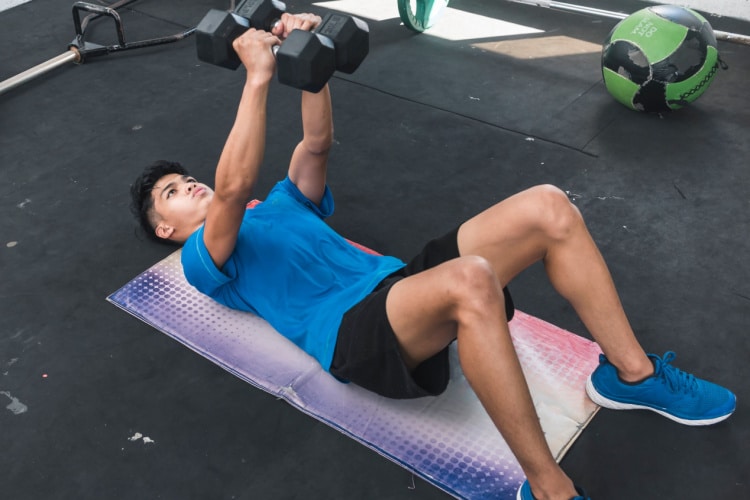
Movement Category: Tertiary
Programming: 2-4 sets of 10-15 repetitions
Weight: Use a weight that leaves you 1 to 2 reps short of failure, e.g. RPE 8 to 9.
How to do the hex press:
- Get a pair of dumbbells and sit on the end of a weight bench. In a controlled motion, kick off the ground with both feet and rock backward. Extend your arms as you lie on the bench and position both feet firmly.
- Brace your core and hold both dumbbells together at arm’s length above your shoulders. Make sure your palms are facing each other and the dumbbells’ sides are touching each other directly.
- Lower the weights toward your abdomen with the dumbbells pressed together. Once the weights touch your chest, press them back to the beginning position. Make sure they’re in contact with each other at all times.
Have your arms tucked tightly to your sides as you lower the weights. Also, push the dumbbells together as though you were trying to make them a single unit.
What are the Benefits of Training the Inner Chest?
Working out your chest is more than just about aesthetics — here are some of the benefits.
Build Muscle Mass and Strength
Performing inner chest exercises, and lifting weights in general, helps build muscle mass and strength. That said, when we discuss muscle strength, we aren’t only describing a muscle group’s capacity to build maximal low velocity force in the gym, e.g. a 1-Repetition Maximum bench press. Rather, strength training has been shown to improve other types of strength such as muscular endurance, strength stamina, and high velocity force production (power). [3, 4]
Better Respiratory Capacity
Training the upper body, including the pecs, might improve respiratory capacity and breathing in certain people. A study focusing on male smokers, half of whom lifted weights, including the chest press, and half who didn’t, shows that these people’s breathing capacity improved. [5]
In COPS (Chronic Obstructive Pulmonary Disease), muscular dysfunction is said to affect patient symptoms, functional capability, life quality, healthcare utilization, and mortality. Resistance training lowers systemic inflammatory marker levels, boosts muscular hypertrophy and strength, enhances muscle endurance, and enhances functional ability and quality of life in these patients. [6]
Versatility
Although our main focus today is on the inner chest muscles, it’s worth mentioning that apart from improving your inner chest and other chest muscles, most chest exercises involve other muscles as well. For example, all pressing exercises require the anterior deltoid and triceps brachii muscles to contribute to the movement. Additionally, most flye-type exercises require the biceps brachii to produce force in order to complete the exercise. [7] Again, you’re working far more than just your “inner chest” when you perform these exercises.
Better Athletic Performance
In general, improving muscular strength via training in the gym increases performance potential in sports. However, strength is specific to how it is developed, meaning that improving your bench press and/or increasing the size of your chest may or may not transfer very well to a particular sport.
Many sports require high levels of chest strength, which is why tennis players, football players, boxers, and even golfers are likely to benefit from incorporating chest exercises into their routines.
For example, we do have data showing that upper body strength, as measured by the bench press, correlates with higher club head speed in golf and punching velocity in boxing. [8]
Improved Cardiovascular Health
Engaging in any of the above-mentioned exercises can greatly improve your cardiovascular health. A 2019 study shows that men who can do 50 push-ups are said to have fewer cardiovascular diseases as opposed to those who can’t even perform ten. [9]
Also, resistance training is assumed to have a positive impact on risk factors for cardiovascular health — it lowers blood pressure and improves body composition, insulin sensitivity, and dyslipidemia. [10]
Tips for Effective Inner Chest Exercises
Here are some things to keep in mind if you want to get the most out of your inner chest exercises:
- Adjust the volume to suit your own needs. Volume refers to the total number of sets and repetitions done over a specific amount of time, usually a week. The optimal volume for a given individual depends on their current fitness levels, genetics, and previous training history, even though higher volume programs often result in greater muscle growth. For chest training, we advise starting with roughly 10 to 15 sets per week and observing your response after a few weeks. Increasing volume too rapidly may exceed your capacity to recover and adjust to your workout.
- Gradually increase load. As you get stronger, increase the weight being lifted to match your newfound fitness level. We expect strength performance to increase every few weeks on average, but make sure the weight you’re lifting matches the RPE recommendations given so that the muscles are properly loaded.
- Pick the right exercises for you. There are no super-secret or special exercises that have to be done. Rather, picking exercises you can do based on equipment access and like performing are the biggest factors here. Don’t feel pressured to copy what influencers are doing.
- Understand that seeing results takes time. Don’t expect overnight results — instead, devote yourself to a consistent chest exercise regime and stick to it. Learn to trust the process even when you haven’t seen any results yet.
If you have any previous or pre-existing health condition, see our article on “Pain in Training: What to Do” to find your entry point to exercise. If you need professional help, feel free to contact us.
Conclusion
All in all, chest workouts are an effective way to not only improve your chest aesthetically but also build muscle strength and endurance. If you’re interested in maximizing your strength gains, but you aren’t confident in your approach, consider expanding your workout routine with a comprehensive program.
We invite you to have a look at our training templates. And if you’re up for something customized, you can always get in touch with us and get a personalized program working alongside one of our coaches, who’ll devise a workout plan that’s aligned with your current body and fitness goals.
References
1. Solstad, Tom Erik, et al. “A Comparison of Muscle Activation between Barbell Bench Press and Dumbbell Flyes in Resistance-Trained Males.” Journal of sports science & medicine vol. 19,4 645-651. 19 Nov. 2020
2. Gentil, Paulo, et al. “A Review of the Acute Effects and Long-Term Adaptations of Single- and Multi-Joint Exercises during Resistance Training.” Sports medicine (Auckland, N.Z.) vol. 47,5 (2017): 843-855. doi:10.1007/s40279-016-0627-5
3. Andersen V, Prieske O, Stien N, Cumming K, Solstad TEJ, Paulsen G, van den Tillaar R, Pedersen H, Saeterbakken AH. Comparing the effects of variable and traditional resistance training on maximal strength and muscle power in healthy adults: A systematic review and meta-analysis. J Sci Med Sport. 2022 Dec;25(12):1023-1032. doi: 10.1016/j.jsams.2022.08.009. Epub 2022 Aug 28. PMID: 36130847.
4. Balabinis CP, Psarakis CH, Moukas M, Vassiliou MP, Behrakis PK. Early phase changes by concurrent endurance and strength training. J Strength Cond Res. 2003 May;17(2):393-401. doi: 10.1519/1533-4287(2003)017<0393:epcbce>2.0.co;2. PMID: 12741884.
5. Singh, V P et al. “Effects of upper body resistance training on pulmonary functions in sedentary male smokers.” Lung India: official organ of Indian Chest Society vol. 28,3 (2011): 169-73. doi:10.4103/0970-2113.83971
6. Vonbank, Karin, et al. “Strength training increases maximum working capacity in patients with COPD–randomized clinical trial comparing three training modalities.” Respiratory medicine vol. 106,4 (2012): 557-63. doi:10.1016/j.rmed.2011.11.005
7. Saeterbakken, A. H., Mo, D.-A., Scott, S., & Andersen, V. (2017, June 22). The Effects of Bench Press Variations in Competitive Athletes on Muscle Activity and Performance. Journal of Human Kinetics, 57(1), 61–71. https://doi.org/10.1515/hukin-2017-0047
8. Sorbie, G. G., Glen, J., & Richardson, A. K. (2020). Positive Relationships Between Golf Performance Variables and Upper Body Power Capabilities. Journal of Strength and Conditioning Research, Publish Ahead of Print. https://doi.org/10.1519/jsc.0000000000003788
9. Yang, J., Christophi, C. A., Farioli, A., Baur, D. M., Moffatt, S., Zollinger, T. W., & Kales, S. N. (2019, February 15). Association Between Push-up Exercise Capacity and Future Cardiovascular Events Among Active Adult Men. JAMA Network Open, 2(2), e188341. https://doi.org/10.1001/jamanetworkopen.2018.8341
10. Ho, S. S., Dhaliwal, S. S., Hills, A. P., & Pal, S. (2012, August 28). The effect of 12 weeks of aerobic, resistance, or combination exercise training on cardiovascular risk factors in the overweight and obese in a randomized trial. BMC Public Health, 12(1). https://doi.org/10.1186/1471-2458-12-704